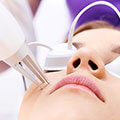Treatments
1. Dental Cleanings (Prophylaxis):
Dental cleanings involve the removal of plaque, tartar (hardened plaque), and stains from the teeth. The dentist or dental hygienist uses special instruments to scrape and polish the teeth. Dental cleanings help prevent gum disease, tooth decay, and maintain overall oral health.
2. Fillings:
Fillings are used to repair teeth damaged by decay or minor fractures. The dentist removes the decayed portion of the tooth and fills the cavity with a filling material, such as composite resin, amalgam, or porcelain. Fillings restore the tooth's function and prevent further decay.
3. Dental Crowns:
Crowns, also known as caps, are tooth-shaped restorations that cover and protect a damaged tooth. They are typically recommended for teeth with extensive decay, fractures, or after root canal treatment. Crowns can be made from various materials, including porcelain, metal alloys, or a combination of both.
4. Fillings:
If a child has a cavity, the decayed portion of the tooth is removed, and a filling material (such as composite resin or amalgam) is used to restore the tooth's structure and function. Fillings prevent further decay and restore the tooth's appearance.
5. Root Canal Treatment:
Root canal treatment is performed when the tooth's pulp, which contains nerves and blood vessels, becomes infected or damaged. The dentist removes the infected pulp, cleans and disinfects the root canals, and seals them with a biocompatible material. A crown is often placed on the tooth to restore its strength and appearance.
6. Dental Bridges:
Bridges are used to replace one or more missing teeth. They consist of artificial teeth (pontics) that are supported by adjacent natural teeth or dental implants. Dental bridges improve aesthetics, restore chewing function, and help maintain proper tooth alignment.
7. Orthodontic Evaluation:
An orthodontic evaluation is performed to assess the child's dental alignment and bite. If orthodontic issues are identified, the child may be referred to an orthodontist for further evaluation and possible treatment with braces or other orthodontic appliances.
8. Dental Implants::
Dental implants are artificial tooth roots that are surgically placed into the jawbone. They serve as anchors for replacement teeth (crowns, bridges, or dentures). Dental implants provide a durable and natural-looking solution for tooth loss, improving appearance, speech, and chewing ability.
9. Dentures:
Dentures are removable appliances used to replace missing teeth and surrounding tissues. They can be partial dentures (replacing several missing teeth) or complete dentures (replacing all teeth in an arch). Dentures restore oral function, improve aesthetics, and support facial structure.
10. Orthodontic Treatment:
Orthodontic treatment focuses on correcting misaligned teeth and improper jaw positioning. Braces, aligners (such as Invisalign), or other orthodontic appliances are used to gradually move teeth into their correct positions. Orthodontic treatment improves dental alignment, bite function, and overall smile aesthetics.
11.Teeth Whitening:
Teeth whitening procedures are used to lighten the shade of natural teeth. They can be performed in-office by a dental professional or at home using custom-fitted trays and whitening gel. Teeth whitening helps remove stains and discoloration, enhancing the appearance of the teeth
12. Oral Surgery:
Oral surgery encompasses various procedures, including tooth extractions, wisdom teeth removal, dental implant placement, corrective jaw surgery, and treatment of oral pathologies.





